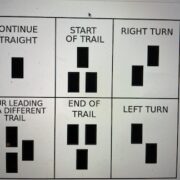
‘Tis the Season … for a Winter Hike!
(December) There’s something magical about walking in the woods in winter – it’s peaceful and quiet especially under a blanket of snow. The air is brisk and invigorating, and your breath turns into little puffs of clouds. Without its summer foliage and brush, the forest dons a whole new look, stark and beautiful and revealing secrets around you. There may be icicles sparkling in the sun. Nests perched on tree branches. Birds searching for a tidbit of food. Little animal tracks to identify in the snow. And carpets of emerald-green moss under foot.
Here are a few tips for staying warm on a winter hike:
- Check the weather. Know what’s in the forecast before you head out.
- Layer, layer, layer. Wearing several layers of clothing helps keep you warm, and lets you adjust if needed to avoid overheating. Consider a lightweight base layer close to your skin, a mid layer that keeps you warm, and an outer layer that protects from wind and moisture.
- Hat on! You can lose a lot of heat through your head so be sure to wear a hat and cover your ears.
- Warm hands. Try lightweight fleece gloves under waterproof gloves or mittens.
- And feet. Keep your feet warm with synthetic or wool socks inside your boots; carry an extra pair in case they get wet.
- Don’t squint. Bring along your sunglasses to protect your eyes, especially from glare on a snowy day.
- Sun sense. Use sunscreen on your nose and cheeks to keep your skin safe from those bright winter rays.
- Water, baby. Be sure to stay hydrated by drinking plenty of water. A warm drink in an insulated container – like hot chocolate – might warm you up, too!
- Use poles. Trekking poles can help improve your traction, footing and balance on snowy and icy trails.
- Keep on track. Be sure you know your route; use a trail map or compass. Don’t rely on your cell phone as service may be spotty. Take a buddy along. And let someone else know where you’re going and when you expect to be back, particularly if you’ll be out of cell phone service range.
- Have fun!
[wpforms id=”4145″]
Previous Trail Tips:
Autumn Tips: Sharing the Land with Each Other During Hunting Season
(November) Autumn is beautiful in southeastern Ohio and the beginning of a unique outdoor recreational season. Many folks trek to our preserves to participate in a myriad of outdoor pursuits. How can these varied activities seamlessly share the same spaces?
Diverse activities are allowed on Athens Conservancy preserves, including hiking, trail running, wildlife and plant observation, and deer hunting.
- Hiking and trail running depend on well-maintained trails. These trails are developed and maintained to allow safe and environmentally sound access to these lands. By focusing hiking and running activities on developed trails, erosion can be reduced, and protection of sensitive ecological systems can be achieved.
- Observation of wildlife and plants is another popular activity. Most participants use the same trail systems as hikers and trail runners. Nature observers provide all of us with insights into the biota inhabiting the lands and the condition of the habitat.
- Deer hunters use our public lands primarily during the fall. Hunting seasons for archery and gun hunters differ (see below for this year’s season dates). For other information, consult the ODNR website. On Athens Conservancy preserves, only deer hunting is permitted. Harvesting deer helps control population density, reducing the potential for over-browsing of native plants, wildlife disease outbreaks, and incidences of human-deer conflicts (i.e., vehicle collisions). Venison provides consumers with a highly nutritional protein source especially in food-insecure regions.
How can we participate in outdoor recreational activities and respect our fellow conservationists?
- Educate yourself on the regulations concerning outdoor activities. Information is available from sources such as the organization that manages the land or oversees the activity.
- Off-trail walking is allowed on Athens Conservancy preserves, but special caution is needed. For non-hunters, limit off-trail walking during deer hunting season to reduce the potential of “walking-up” on a hunter. For hunters, avoid hunting or field-dressing a deer within 150 feet of any established trail. For all outdoor participants, avoid areas of high erosion potential and ecologically sensitive areas.
- All outdoor recreational participants should wear highly visible clothing during hunting season, whether you are a hunter or hiker. Fluorescent orange or green is the most visible but other bright colors are also useful.
- Most hunting activities are focused on peak animal movement periods, primarily early-morning and late-afternoon. For other recreational users during deer hunting season, consider a midday hike or run.
- Engage in a respectful conversation when you encounter others. We all benefit by sharing our outdoor experiences.
Ohio Deer Hunting Dates:
Archery: Sept. 30, 2023 – Feb. 4, 2024
Youth Gun: Nov. 18 – 19, 2023
Gun: Nov. 27 – Dec. 3, 2023; Dec. 16-17, 2023
Muzzleloader: Jan. 6 – 9, 2024
Athens Conservancy Preserves and hunting:
Archery Only Hunting: Blair, Bluebell, Brookville, Canaan, Deep Hollow-Dark Skies, Lindy Roosenburg, Mary Beth Zak Lohse, Poston, Skunk Run, and Tucker Run
Archery and Gun Hunting: Baker
Trail Signs — How to Find Your Way
(September) There’s nothing quite like exploring the natural beauty of fall in southeastern Ohio. But if you’re perplexed about navigating your way along a trail, here are some tips:
Online resources to access on your phone:
- Online GPS-based navigational applications can provide help in finding trail heads, user reviews of trails, and information on trail gradient linked to maps.
- Topographic maps may provide information about how steep a trail is. When reading topographic maps, remember the closer the elevation lines, the steeper the trail gradient.
- When using these applications, you can follow your progress using a geo-locator to track your location with a circle on the map.
No connection? Some rural trails may not have internet access, but you can plan ahead:
- Many online applications allow you to download their maps onto your device ahead of time, and use them without internet access.
- Or, go “old-school” and use hard copy maps to follow the trail and other landmarks.
On-trail navigation help:
- Trail signs are usually placed at trail heads and when trails intersect. Many signs provide the trail name, levels of difficulty, and distance. The color of the trail blazes is often included.
- Blazes are located along the trail usually on trees, or on posts or rock outcroppings. The rectangular blazes (2-inch x 6-inch) are posted at eye level about every 200 yards. One color is used for a trail throughout its course. On the 2,190-mile Appalachian Trail, white blazes are used from Georgia to Maine.
- A single vertical rectangular blaze (reassurance blazes) indicates that the trail is straight.
- A single angled rectangular blaze or two rectangular blazes (directional blazes) indicate an upcoming right or left turn.
- Three rectangular blazes indicate the start or end of a trail.
- Spur or intersecting trails are noted by different color markers. Often as you approach an intersecting trail, two colored rectangular markers are used to alert a hiker of an upcoming spur trail.
- Rock cairns are often used to mark a trail in areas with limited or no trees. Cairns are usually at a height distinguishable from other landmarks.
Trail markers are placed for hikers’ guidance and safety and should not be moved, defaced, removed, or changed.
Ick! Tick Tips
(August) Summertime! Hiking! Nature! All good stuff … with the exception of one creepy-crawly icky little pest – ticks. These tiny, pesky arachnids are common in Ohio, especially during the warmer months, and in wooded, brushy, and grassy areas.
But knowing your tick facts and taking a few preventive measures can help you avoid – or deal with — a dreaded tick encounter.
Three types of ticks most likely to be found in Ohio are the American dog tick, the black-legged tick, and the lone star tick. All three can cause tickborne illnesses from their bites. See the image below, from of the Ohio Department of Health.
Tick Tips:
- Take a hike … but try to avoid overgrown, brushy areas with high grass and leaf litter. Stay on trails, and walk in the middle of the trail.
- Consider treating your gear beforehand with products containing 0.5% permethrin, an insecticide that can be applied to clothing, socks, and boots, and can last through several washings. Be sure to follow directions for use.
- Apply bug spray. If you use an insect repellent, choose an EPA-recommended product labeled for use against ticks. Follow directions on the product label. There are many options, from insecticides containing DEET to more-natural botanical products containing citronella.
- Suit up. Wear light-colored clothing, and don long pants and sleeves. Tuck your pants into your socks (so trendy!). Limit exposed skin.
- When you get home, check your clothing for ticks – they can hitchhike inside. Remove any ticks you find. Put your clothes in the dryer on high heat for 10-15 minutes to kill any lingerers.
- Get naked. Take off your clothes and do a body check for ticks. Check tick hotspots like armpits, groin, behind knees, and behind your ears. Jump in the shower and scrub.
- Yikes! If you find a tick, don’t despair. If it’s crawling on your skin, catch the tick; use a piece of tape to trap it and throw it away.
- If you find a tick that has bitten and is lodged in your skin, remove it quickly. Use a pair of tweezers to grab it close to your skin. Pull straight away; don’t twist. Place the live tick in a sealed bag or container, wrap it tightly in tape, or flush it down the toilet. Wash the bite area and your hands.
- If you are bitten by a tick, and have any suspicious health symptoms, consult your doctor.
Ticks may be creepy, but don’t let them spoil your outdoor fun. Just stay informed and take a few precautions. The joys of being outdoors outweigh these little buggers.

July Tips: Trail Fashion — What to Wear
Suiting up for a hike? Here are a few things to keep in mind. Happy feet mean a happy hiker, so let’s start there.
- Socks. Avoid cotton! Cotton holds moisture and is a no-no for hiking. Depending on weather, wool, polyester, nylon, or silk and their blends are preferable. Light to medium weight socks will keep your feet happy. If blisters are a problem, consider toe socks. Use moisture-wicking or quick-drying socks.
- Footwear. Endless choices include hiking boots, hiking shoes, trail running shoes, and hiking sandals. Just be sure your shoes are sturdy (leave your flip-flops at home!). Consider ankle support, insole cushioning, outsole grip, and outer uppers and waterproof membranes. Hiking boots and mid-level shoes are best for ankle support. Insole cushioning leads to happy feet and legs. Choose footwear with replaceable insoles. Outsoles should be balanced providing enhanced “grippiness” over a wide range of surfaces.
- Clothing. Fabrics should be moisture-wicking or quick-drying; no cotton or denim, which can get damp or sweaty. A wide choice of pants is available. Convertible pants that zip off to shorts are great for milder weather or if in “tick country”. Choose pants with at least one zipper pocket for storage, and a style that allows movement. Layer shirts and choose what works for the weather. Sun-protective fabrics are available.
- Outerwear. It’s the first defense against elements. For spring, summer and fall, choose a jacket or pullover in a non-cotton fleece. For cooler weather, a packable puffer jacket works.
- Rainwear. Packable rainwear is lightweight and easy to layer over other clothing. Hats and gloves should be lightweight, moisture-wicking or quick-drying, and easy to pack.
- Hats. In summer, a wide-brimmed hat can shield the sun. In winter, a beanie keeps you warm, and for warm-weather hikes a bandana keeps you cool. Protective gloves help when rock scrambling.
- Day pack. A day pack lets you easily carry the “essentials” – a jacket, hat, extra socks, first aid items, and of course, your water and snack. A day pack in the 10-40-liter size with a hip belt and outer pockets is adequate.
- Clothing colors. High visibility colors or reflectivity in some of your outer clothing or day pack will provide a level of safety.
Enjoy your trail trek! Check us out next month for a round-up of Ticks and Other Pests.
Let’s Go! Tips to Start Hitting the Trails
(June 2023) The sun is shining, wildflowers are in bloom, and birds are singing in the trees. A perfect time to hike on the many wonderful trails in Southeast Ohio.
Whether you’re brand-new to hiking, or just need to refresh your trail know-how, here are some helpful tips to get started:
- Consider your physical condition: Be honest about your fitness level; no one wants to overextend themselves! A short hike on an easy-level trail is a great way to start. Rail trails, bike paths or city parks are ideal for a first trek to assess your stamina while enjoying the natural world.
- Gear up: Dress for the weather and wear layers in case you warm up while moving along the trail.
- Shoe sense: Shoes are important (leave the flip-flops at home). Wear comfortable and sturdy shoes such as a good pair of sneakers or trail runners to get started; later you may choose to invest in hiking shoes or boots.
- Hydrate: Bring plenty water to drink and a few easy-to-carry snacks (like a granola bar or trail mix) to keep you going.
- Plan ahead: Check the weather forecast before you head out and allow enough time to return to your vehicle before dark. And always let someone know where you’re going, when you’re hiking, and when you plan to be back.
- Take a buddy: Invite a friend or family member along. Include others and boost your hiking experience and comfort level!
- Be choosy with your first hikes: Choose trails with well-maintained access locations and parking lots, smooth surfaces, and are frequented by fellow hikers.
- Try an organized hike: Many organizations host day hikes that are educational, socially focused, and fun. It’s a good way to meet new and experienced hikers and get acquainted with your local trails.
Thanks for checking out our June tip. Come back in July for our next Trail Tips feature: Trail Fashion: What to Wear on a Hike.




